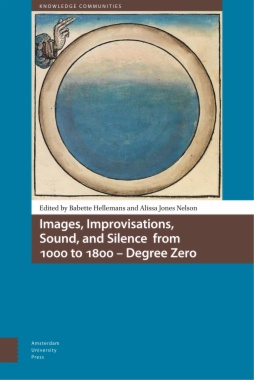The act of drawing a line or uttering a word is often seen as integral to the process of making art. This is especially obvious in music and the visual arts, but applies to literature, performance, and other arts as well. These collected essays, written by scholars from diverse fields, take a historical view of the richness of creation out of nothing (creatio ex nihilo) in order to draw out debates, sometimes implicit and sometimes formally stated, about the production and reproduction of cultural meaning in a period of great change and novelty, between the beginnings of the medieval intellectual tradition and the imprint of the Enlightenment. The authors pose the following questions: Do tradition and creativity conflict with one another, or are they complementary? What are the tensions between composition and live performance? What is the role of the audience in perceiving the object of art? Are such objects fixed or flexible? What about the status of the event? Is the event part of creation, in the sense that it disturbs the still waters of historical continuity? These and other questions build on the foundation of Roland Barthes' concept of Degree Zero, offering new insights into what it means to create.
- Cover
- Table of Contents
- Preface and Acknowledgements
- Ouverture
- Images
- 1. The Two Bodies of the Virgin
- 2. The Three Ages of Man and the Materialization of an Allegory
- 3. Lapsus figurae
- Improvisations
- 4. Drawing a Line and Questioning Art
- 5. Fall and Rise Again
- 6. Improvisation as a Chief Pillar of the Poetic Art in Persian Literary Tradition
- Sound
- 7. Intending the Listener
- 8. The Sovereign Ear
- 9. Where Sound and Meaning Part
- Silence
- 10. Writing about Silence and the Secret in the Twelfth Century
- 11. An Arrangement of Silence
- 12. Dimidia Hora
- List of Contributors
- Index
- List of Figures
- Chapter 1
- Figure 1 The Queen of the Amazons; Cirio de Nazaré, Belém, 13 October 2013.
- Figure 2 The Romaria fluvial; Belém, 12 October 2013.
- Figure 3 Map of the Town of Belém.
- Figure 4 The Virgin in the berlinda; Cirio de Nazaré, Belém, 13 October 2013.
- Figure 5 Ex voto of a house, expressing a wish for a roof to live under; Cirio de Nazaré, Belém, 13 October 2013.
- Figure 6 Shipwreck of the Frigate Sao Joao Batista, off the coast of Pará. Lithograph, 32 x 23 cm, signed by H. Jannim, Paris, first half of the nineteenth century.
- Figure 7 Wooden boat, commemorating the Virgin’s rescue of sailors at sea, sold from stalls in the Praça do Carmo; Cirio de Nazaré, Belém, 13 October 2013.
- Figure 8 Praça do Carmo (Square of the Carmelites); Cirio de Nazaré, Belém, 13 October 2013.
- Figure 9 Image of the corda, the rope that pulls and steers the berlinda, as a central symbol of the procession; Cirio de Nazaré, Belém, 13 October 2013.
- Figure 10 The peregrina on the arraial in front of the Basilica of San Nazaré; Cirio de Nazaré, Belém, 13 October 2013.
- Figure 11 Crowds placing written supplications, promessas, and coloured ribbons around the peregrina on the arraial in front of the Basilica of San Nazaré; Cirio de Nazaré, Belém, 13 October 2013.
- Figure 12 Crowds taking digital photos of the original in the Basilica of San Nazaré; Cirio de Nazaré, Belém, 13 October 2013.
- Figure 13 The wagon on which the statue of Shiva is carried around the perimeter of the temple; Madurai, Tamil Nadu.
- Chapter 2
- Figure 1 Triciput of the Ages of Man, Inv. no. 73/1, Bavarian National Museum, Munich.
- Chapter 3
- Figure 1 L’Insensé. Illustration no. 81 in Garnier, L’âne à la lyre, sottisier d’iconographie médiévale (Paris: Léopard d’or, 1988); negative by Pierre-Olivier Dittmar.
- Figure 2 Moses receiving the tablets of the law and the adoration of the golden calf, Psalter of Blanche of Castile, early thirteenth century; Paris BnF, Arsenal, ms. 1186, f. 14, negative Bibliothèque nationale de France.
- Figure 3 ‘A Jew looks on the weeping earth’, Psalter of Marote de Hamel; Paris, BnF. Lat. 10435, f. 11v., end of the thirteenth century, negative Bibliothèque nationale de France.
- Figure 4 ‘Abraham repudiates his wife and son in the desert’, Bible of Pamplona; Amiens, Bibliothèque Municipale, ms. 108, f. 11. circa 1197.
- Chapter 4
- Figure 1 Agostino Carracci, Studies of ears and profile heads; pen and brown ink, 15.1 x 10.8 cm, The Nationalmuseum Stockholm.
- Figure 2 Agostino Carracci, Studies of three profile heads; pen and brown ink, 15 x 10.3 cm, The Nationalmuseum Stockholm.
- Figure 3 Attributed to Luca Ciamberlano, after Agostino Carracci, Scuola Perfetta: Studies of two eyes, two ears and two lower portions of the face, in pairs, one in outline; engraving, 167 x 116 mm, ca. 1600–1630, The British Museum.
- Figure 4 Agostino Carracci, Two men in a landscape; pen and brown ink, 15 x 10.3 cm, The Nationalmuseum Stockholm.
- Chapter 7
- Figure 1 W.A. Mozart, Symphony 29 in A major, K. 201, beginning of the first movement. The + denotes sound and the – absence of sound; > stands for the main accent; / refers to the bar line. The complete pattern extends between the two *.
- Figure 2 Johann Sebastian Bach, Toccata, Adagio and Fugue in C major, BWV 564, Fugue m. 78–83 and 87–92, upper voice.

